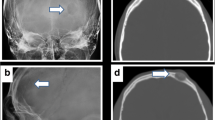Abstract
Background
Cavernous hemangiomas are benign vascular malformations, probably representing the most common intraorbital and intraconal tumors in the adult population.
Case presentation
We report the case of a 49-year-old female with two intra-conal lesions. We performed a total resection using Ulivieri's extended lateral approach. The postoperative course was uneventful and the patient was discharged three days after surgery.
Conclusions
To the best of our knowledge, we report here the first case in the literature of a double intra-conal lesion.
Similar content being viewed by others
Introduction
Cavernous hemangioma is a benign vascular malformation, which probably represents the most common intraorbital and intraconal tumor in the adult population [1,2,3]. When the lesion is small, it can be followed up with clinical examination and serial neuroimaging. If the lesion reaches a considerable size with the onset of neurological deficits, surgical removal becomes mandatory. In our Department of Neurosurgery we usually perform, as in this case, an extended lateral approach to the orbit [4, 5].
Case presentation
We present the case of a 49-year-old woman who presented with a history of severe orbital pain of a few months duration and the presence of a progressive exophthalmos on the left eye. Neurological examination revealed no neurological deficits or impairment in visual acuity except for an upward and outward 22-mm proptosis of the left eyeball. A computed tomography (CT) scan of the brain showed the concurrent presence of two well-defined and circumscribed intra-conal lesions on the left side of the orbit (Fig. 1). The tumor was surgically removed by Ulivieri’s extended lateral approach with cryoprobe technique (Fig. 2). Histopathological examination showed a benign vascular lesion consisting of a cavernous hemangioma.
The postoperative course was uneventful, without any complication and the patient was discharged three days after the operation.
Conclusions
Hemangiomas are the most common intraorbital tumors in the adults and the second most common cause of proptosis after thyroid disease [6]. Patients typically present in their 3rd to 5th decade with unilateral, painless proptosis. Decrease in visual acuity from mild compression of optic nerve is often subtle. These lesions more commonly occur in women who may experience clinical worsening during pregnancy [7]. Pre-operative diagnostic work-up includes complete ophthalmologic examination, and neuroimaging examinations such as CT or magnetic resonance imaging (MRI).
Hemangiomas are defined as intraconal tumors as they are most commonly located between the optic nerve and the extraocular muscles.
Histopathology shows a benign vascular malformation characterized by multiple large vascular channels covered by endothelial cells and abundant stroma. The vascular lumen is filled with blood and variable regions of intralesional thrombosis, reflecting vascular stasis and/or very slow blood flow. Endothelial cells appear as mature vascular elements. The stromal structure shows perivascular hypercellularity or hyperplastic elements related to neovascular activity [8].
To the best of our knowledge, we report here the first case in the literature of a double intra-conal lesion.
Availability of data and materials
Data and material are available from the corresponding author on reasonable request.
Abbreviations
- CT:
-
Computed tomography
- MRI:
-
Magnetic resonance imaging
References
D’Hermies F, Elmaleh C, Mourier K, Berges O, Clay C. Cavernous hemangioma of the orbit. J Fr Ophtalmol. 1993;16:195–8.
Naggara O, Koskas P, Lafitte F, Hern F, Piekarsky J, Meder JF, et al. Vascular tumours and malformation of the orbit. J Radiol. 2006;87:17–27.
Ulivieri S, Tacconi L, Luglietto D, Oliveri G. Cryosurgical treatment for the removal of orbital cavernous hemangiomas: our experience. Eur J Oral Maxillofac Surg. 2018;2:30–3.
Ulivieri S, Cellini L, Luglietto D, Oliveri G, Giorgio A. Surgical approach to the orbit modifying the standard lateral Kronlein technique. Minerva Oftalmol. 2019;61:31–5.
Ulivieri S, Giorgio A. Ulivieri’s extended lateral approach to orbital surgery: technical notes. Minerva Oftalmol. 2020;52(1–2):9–11.
McNab AA, Wright JE. Cavernous haemangiomas of the orbit. Aust N Z J Ophthalmol. 1989;17:337–45.
Henderson GW. Vascular hamartomas, hyperplasias, and neoplasms. In: Henderson GW, editor. Orbital tumors. New York: Raven Press; 1994. p. 94–100.
Iwamoto T, Jakobiec FA. Ultrastructural comparison of capillary and cavernous hemangiomas of the orbit. Arch Ophthalmol. 1979;97(6):1144–53.
Acknowledgements
None.
Funding
None.
Author information
Authors and Affiliations
Contributions
SU performed the neurosurgical procedure, evaluated the patient and wrote the paper. DL helped to write the paper and participated in the evaluation of the patient and in the neurosurgical procedure. MU helped to write the paper. AG helped to write the paper. All authors have read and approved this paper.
Corresponding author
Ethics declarations
Ethics approval and consent to participate
This is not a study. It is only a case report. There is no patient identification in the paper. The patient’s written permission has been obtained to report this case.
Consent for publication
Written informed consent was obtained from the patient for publication of this case report and accompanying images.
Competing interests
The authors declare that they have no competing interests.
Additional information
Publisher's Note
Springer Nature remains neutral with regard to jurisdictional claims in published maps and institutional affiliations.
Rights and permissions
Open Access This article is licensed under a Creative Commons Attribution 4.0 International License, which permits use, sharing, adaptation, distribution and reproduction in any medium or format, as long as you give appropriate credit to the original author(s) and the source, provide a link to the Creative Commons licence, and indicate if changes were made. The images or other third party material in this article are included in the article's Creative Commons licence, unless indicated otherwise in a credit line to the material. If material is not included in the article's Creative Commons licence and your intended use is not permitted by statutory regulation or exceeds the permitted use, you will need to obtain permission directly from the copyright holder. To view a copy of this licence, visit http://creativecommons.org/licenses/by/4.0/.
About this article
Cite this article
Ulivieri, S., Luglietto, D., Ulivieri, M. et al. A unique case of a double intra-conal cavernous hemangioma. Egypt J Neurosurg 36, 29 (2021). https://doi.org/10.1186/s41984-021-00129-7
Received:
Accepted:
Published:
DOI: https://doi.org/10.1186/s41984-021-00129-7






